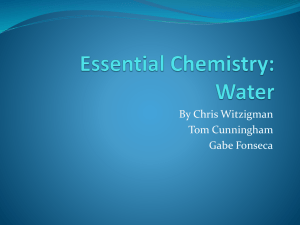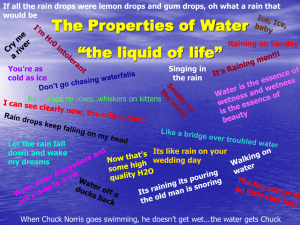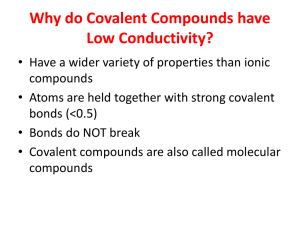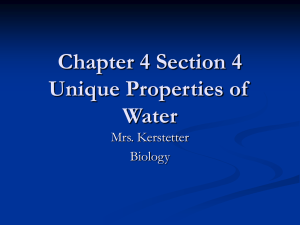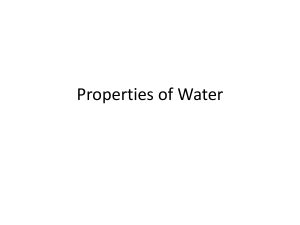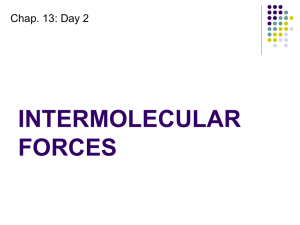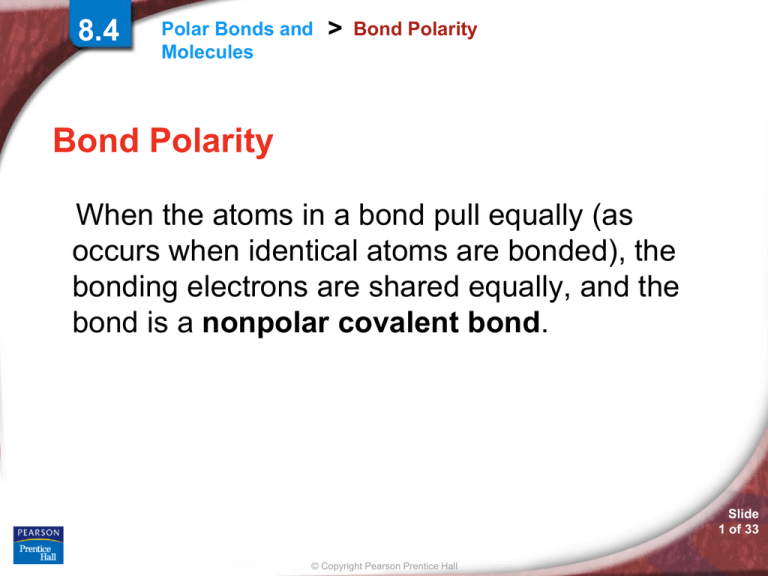
8.4
Polar Bonds and
Molecules
>
Bond Polarity
Bond Polarity
When the atoms in a bond pull equally (as
occurs when identical atoms are bonded), the
bonding electrons are shared equally, and the
bond is a nonpolar covalent bond.
Slide
1 of 33
© Copyright Pearson Prentice Hall
8.4
Polar Bonds and
Molecules
>
Bond Polarity
The bonding pairs of electrons in covalent bonds
are pulled by the nuclei.
Slide
2 of 33
© Copyright Pearson Prentice Hall
8.4
Polar Bonds and
Molecules
>
Bond Polarity
The chlorine atom attracts the shared electrons
more than the hydrogen atom does. (That is, the
electrons are shared unequally.)
Slide
3 of 33
© Copyright Pearson Prentice Hall
8.4
Polar Bonds and
Molecules
>
Bond Polarity
Polar covalent bond (a.k.a. polar bond) a covalent bond between atoms in which
the electrons are shared unequally.
The more electronegative atom
attracts electrons more strongly
and gains a slightly negative
charge.
The less electronegative atom has
a slightly positive charge.
Slide
4 of 33
© Copyright Pearson Prentice Hall
Polar Bonds and
Molecules
>
See page 177
Slide
5 of 33
© Copyright Pearson Prentice Hall
8.4
Polar Bonds and
Molecules
>
Bond Polarity
Slide
6 of 33
© Copyright Pearson Prentice Hall
8.4
Polar Bonds and
Molecules
>
Polar Molecules
Polar Molecules
In a polar molecule, one end of the molecule is
slightly negative and the other end is slightly
positive.
A molecule that has two poles is called a dipolar
molecule.
Slide
7 of 33
© Copyright Pearson Prentice Hall
8.4
Polar Bonds and
Molecules
>
Polar Molecules
A hydrogen chloride molecule is a dipolar molecule.
Slide
8 of 33
© Copyright Pearson Prentice Hall
8.4
Polar Bonds and
Molecules
>
Attractions Between Molecules
Attractions Between Molecules
Intermolecular attractions are weaker
than either ionic or covalent bonds.
These attractions are responsible for
determining whether a molecular compound
is a gas, a liquid, or a solid at a given
temperature.
Slide
9 of 33
© Copyright Pearson Prentice Hall
8.4
Polar Bonds and
Molecules
>
Attractions Between Molecules
Van der Waals Forces
The two weakest attractions between molecules
are collectively called van der Waals forces,
J.Dr.
vanForces
der Waals
named after ______________.
Include 1) dipole interactions
2) dispersion forces
Slide
10 of 33
© Copyright Pearson Prentice Hall
8.4
Polar Bonds and
Molecules
>
Attractions Between Molecules
Dipole interactions
occur when polar
molecules are
attracted to one
another.
Slide
11 of 33
© Copyright Pearson Prentice Hall
8.4
Polar Bonds and
Molecules
>
Attractions Between Molecules
Dispersion forces, the weakest of all molecular
interactions, are caused by the motion of
electrons.
Slide
12 of 33
© Copyright Pearson Prentice Hall
8.4
Polar Bonds and
Molecules
>
Attractions Between Molecules
Hydrogen Bonds
Hydrogen bonds are attractive forces in which
a hydrogen covalently bonded to a very
electronegative atom is also weakly bonded to
an unshared electron pair of another
electronegative atom.
Slide
13 of 33
© Copyright Pearson Prentice Hall
8.4
Polar Bonds and
Molecules
>
Attractions Between Molecules
Hydrogen Bonding in Water
Slide
14 of 33
© Copyright Pearson Prentice Hall
8.4
Polar Bonds and
Molecules
>
Attractions Between Molecules
The relatively strong attractive forces between
water molecules cause the water to form small
drops on a waxy surface,
like on a sweaty basketball
player (Wolfe, 85).
Slide
15 of 33
© Copyright Pearson Prentice Hall
8.4
Polar Bonds and
Molecules
>
Intermolecular Attractions and Molecular
Properties
Intermolecular Attractions and Molecular
Properties
Network solids (or network crystals) are solids
in which all of the atoms are covalently bonded
to each other.
Network solids consist of molecules that do not
melt until the temperature reaches 1000°C or
higher, or they decompose without melting at all.
Slide
16 of 33
© Copyright Pearson Prentice Hall
8.4
Polar Bonds and
Molecules
>
Intermolecular Attractions and Molecular
Properties
Diamond is an example of a network solid.
Diamond does not melt. It vaporizes to a gas at
3500°C or above.
Slide
17 of 33
© Copyright Pearson Prentice Hall
8.4
Polar Bonds and
Molecules
>
Intermolecular Properties and Molecular
Properties
Melting a network solid would require
breaking covalent bonds throughout the
solid.
Slide
18 of 33
© Copyright Pearson Prentice Hall
8.4
Polar Bonds and
Molecules
>
Intermolecular Attractions and Molecular
Properties
Silicon Carbide is a network solid. It has a
melting point of about 2700°C.
Slide
19 of 33
© Copyright Pearson Prentice Hall
8.4
Polar Bonds and
Molecules
>
Intermolecular Attractions and Molecular
Properties
Slide
20 of 33
© Copyright Pearson Prentice Hall
8.4 Section Quiz.
1. In a molecule, the atom with the largest
electronegativity value
a. repels electrons more strongly and aquires a
slightly negative charge.
b. repels electrons more strongly and aquires a
slightly positive charge.
c. attracts electrons more strongly and aquires a
slightly positive charge.
d. attracts electrons more strongly and aquires a
slightly negative charge.
Slide
21 of 33
© Copyright Pearson Prentice Hall
8.4 Section Quiz.
2. When polar molecules are placed between
oppositely charged plates, the negative
a. molecules stick to the positive plates.
b. molecules stick to the negative plates.
c. ends of the molecules turn toward the
positive plates.
d. ends of the molecules turn toward the
negative plates.
Slide
22 of 33
© Copyright Pearson Prentice Hall
8.4 Section Quiz.
3. Which of the following bond types is the
weakest?
a. ionic bond
b. Van der Waals force
c. covalent bond
d. hydrogen bond
Slide
23 of 33
© Copyright Pearson Prentice Hall

